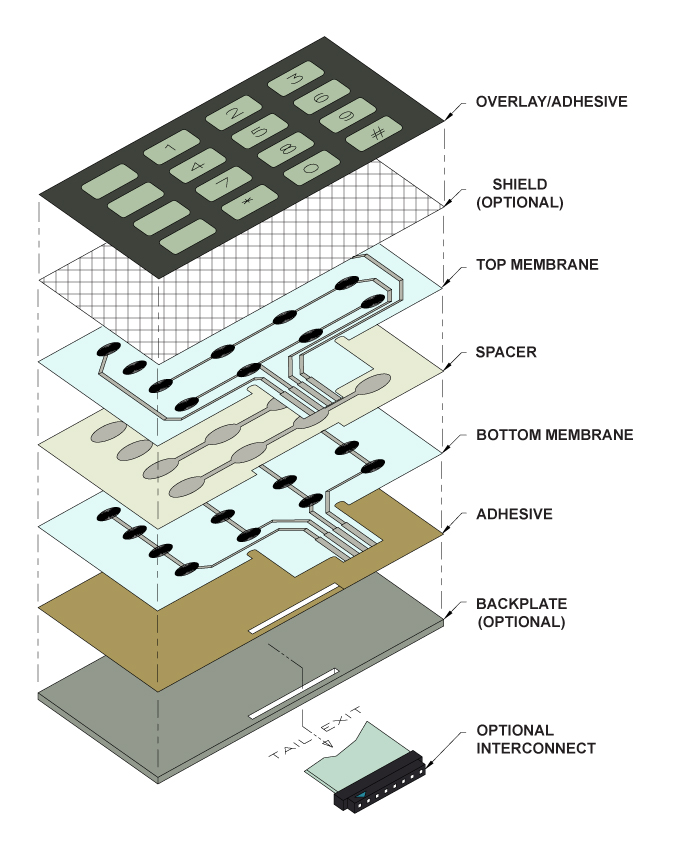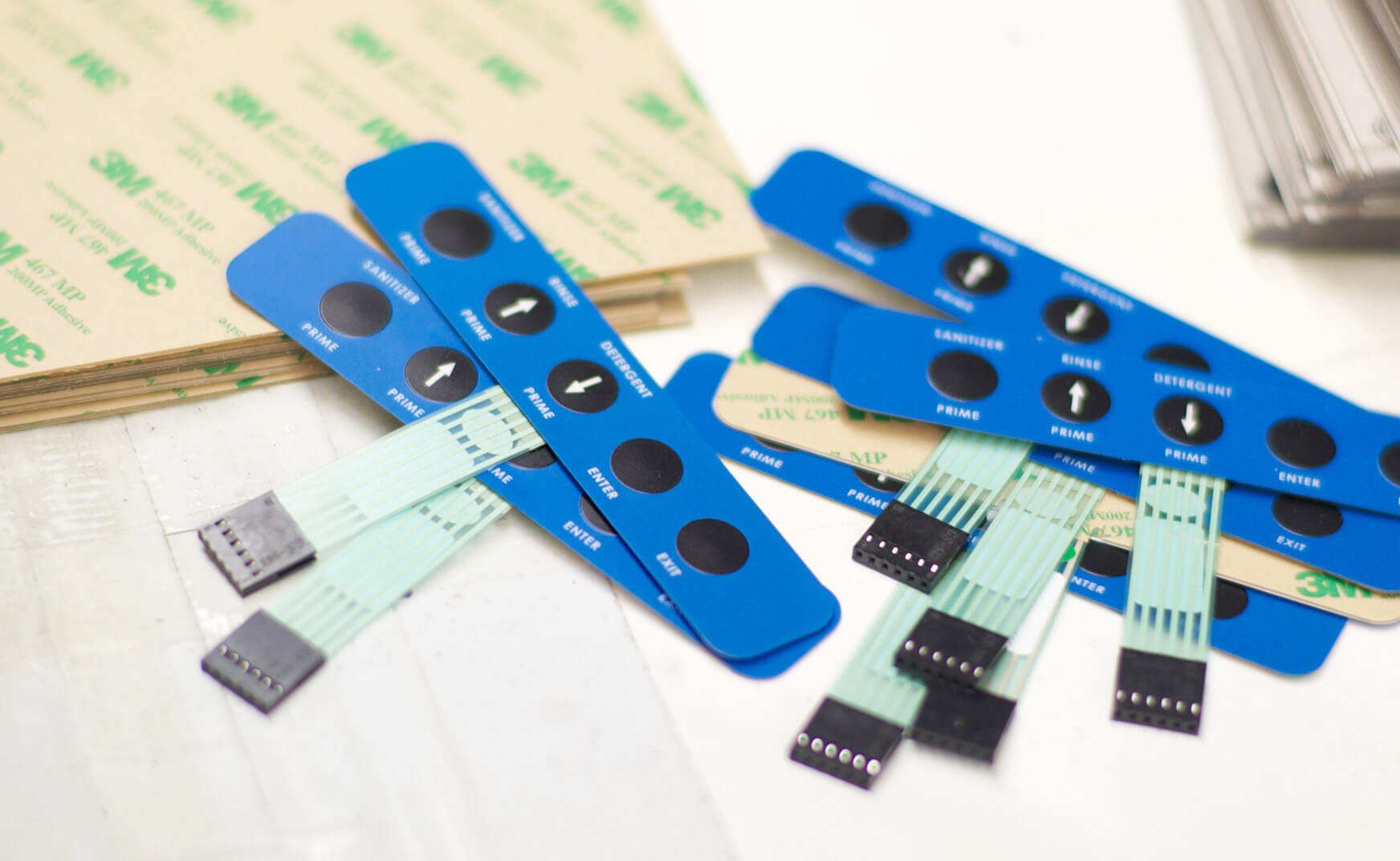Everything About Membrane Layer Change: Understanding Its Layout and Functionality
When you think about the control user interfaces in modern devices, membrane switches typically come to mind. Let's discover what sets membrane layer switches apart from other control systems.
What Are Membrane Buttons?

Membrane layer switches can additionally be personalized regarding shape, dimension, and graphics, permitting makers to create special user interfaces tailored to specific items. Generally, membrane switches play a significant duty in improving user experience throughout a large range of applications.
How Membrane Layer Switches Job
When you push a trick on a membrane button, it triggers a straightforward yet reliable system. The top layer, usually made from flexible material, lowers onto a conductive layer below it. This action bridges the gap between conductive traces, finishing an electrical circuit. As quickly as the circuit shuts, it sends out a signal to the device's controller, which translates your input.
You'll discover that the tactile responses varies based on the button design, using either a soft click or a more noticable feedback. Once you release the trick, the membrane layer go back to its original position, reopening the circuit and stopping the signal. This procedure happens almost instantaneously, guaranteeing a receptive customer experience.
Membrane layer switches are popular because of their sturdiness and resistance to dirt and moisture, making them optimal for different applications, from house devices to medical gadgets. Recognizing this operation helps you value their prevalent usage.
Trick Components of Membrane Switches
Comprehending the vital components of membrane layer buttons is basic for grasping their performance and style. At the core, you'll discover the graphic overlay, which offers the visual interface for individuals. Below that, there's a spacer layer that separates the circuit layers, guaranteeing that they don't make get in touch with up until pressed. The circuit layer is where the magic happens; it contains conductive traces that finish the circuit when you push the button. Another essential element is the sticky support, permitting the switch to follow surface areas firmly. Lastly, the protective layer guards versus environmental elements and wear, extending the button's life-span. Each part plays a substantial duty in making certain trusted efficiency and individual communication. By recognizing these elements, you'll acquire insight right into how membrane layer switches operate and their relevance in numerous applications.
Materials Made Use Of in Membrane Layer Change Design
The efficiency and durability of membrane layer switches over heavily rely on the products utilized in their layout. You commonly come across polyester and polycarbonate as key substrates because of their superb toughness and flexibility. These products resist scrapes and chemicals, making them optimal for requiring environments.
The conductive layers commonly utilize silver or carbon, chosen for their reliability and conductivity. membrane switch manufacturer. Silver provides remarkable performance, while carbon is a cost-effective alternative. For the overlay, you may think about a matte or shiny surface, relying on your aesthetic needs and individual experience
Make specific to select adhesives that stand up to environmental elements like temperature and humidity. Choosing the best materials will assure your membrane layer button stands the examination of time.
Style Considerations for Membrane Buttons
While developing membrane switches, it's important to take right into account numerous elements that influence their performance and customer experience. Start by focusing on the layout and button size; make specific they're intuitive and simple to browse.
Validate your layout suits ecological aspects, like moisture or temperature variations, which could influence efficiency. By meticulously considering these components, you'll create a membrane button that boosts use and satisfaction.
Applications of Membrane Layer Buttons
Membrane layer switches are flexible components located in different applications, from commercial devices to consumer electronic devices. You'll see their influence in makers that need resilient interfaces and in tools that profit from smooth styles. Comprehending these applications helps you value the capability and functionality of membrane layer buttons in daily technology.
Industrial Tools Use
When you're wanting to improve the functionality of industrial tools, membrane layer switches supply a trusted option that combines sturdiness with user-friendly style. These switches are excellent for severe environments, supplying resistance to dust, wetness, and chemicals. You'll find them in control panels for making makers, cooling and heating systems, and medical gadgets, where precision and responsiveness are vital. Their reduced profile suggests they fit effortlessly right into different tools, conserving beneficial area while maintaining simplicity of usage. With customizable graphics and backlighting alternatives, you can create an user-friendly user interface for operators, boosting effectiveness and safety and security. Plus, their long life-span reduces maintenance Source expenses, making them a clever investment for your industrial applications. Accept membrane layer buttons to streamline your procedures and boost total efficiency.
Consumer Electronics Combination
In the domain of consumer electronic devices, membrane buttons play an essential duty in improving individual interaction and device functionality. Membrane layer buttons additionally assure sturdiness and resistance to dust and moisture, extending the lifespan of your electronic devices. By choosing membrane switches, you boost not just the functionality yet additionally the style of your tools, making everyday communications smooth and enjoyable.
Advantages and Drawbacks of Membrane Layer Switches
While membrane layer buttons provide a variety of benefits, they also feature some downsides that you need to think about. One significant advantage is click now their compact layout, making them optimal for space-constrained applications. They're additionally affordable, providing a durable service with a reduced manufacturing price. In enhancement, their seamless surface is very easy to tidy, improving health in atmospheres like medical facilities.

Membrane layer buttons can have a shorter life-span compared to mechanical switches, especially under hefty use. They can also be less responsive, which could impact user comments during procedure. Balancing these pros and disadvantages will certainly assist you identify if membrane layer buttons are the ideal fit for your project.
Frequently Asked Inquiries
How Much Time Do Membrane Switches Over Generally Last?
Membrane switches over typically last between 5 to ten years, depending on usage and ecological conditions. You'll want to assess factors like wear, direct exposure to dampness, and temperature fluctuations to determine their durability properly.
Can Membrane Switches Over Be Personalized for Details Styles?
Yes, you can tailor membrane switches to fit specific styles (membrane switch manufacturer). You'll have the flexibility to choose shades, shapes, and layouts that match your task's requirements, guaranteeing they blend seamlessly with your general visual
What Is the Price Variety for Membrane Layer Change Production?
The price range for membrane switch production normally falls between $1 and $10 each, relying on elements like style complexity, quantity, and materials. You click over here now can get quotes from suppliers to discover the most effective alternative.

Are Membrane Switches Over Waterproof or Resistant?
Membrane switches can be developed to be water resistant or immune, depending on materials used and building methods. If you require them for wet atmospheres, ensure you define those requirements during the design process.
How Do Membrane Switches Compare to Standard Buttons?
Membrane layer buttons are generally thinner and much more flexible than typical buttons, supplying a sleek design. They're often simpler to cleanse and integrate, but may not provide the responsive comments you're used to with mechanical options.
Conclusion
